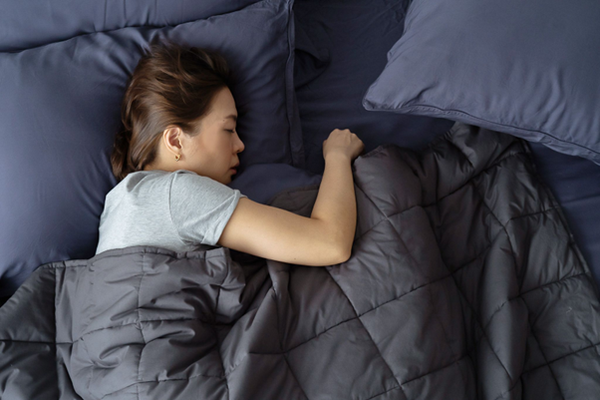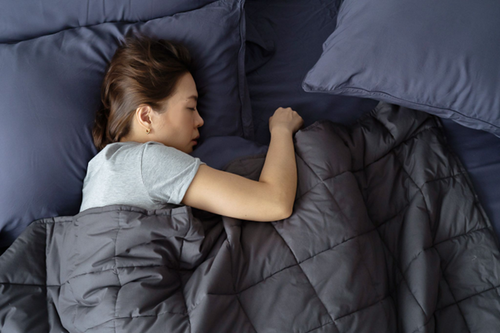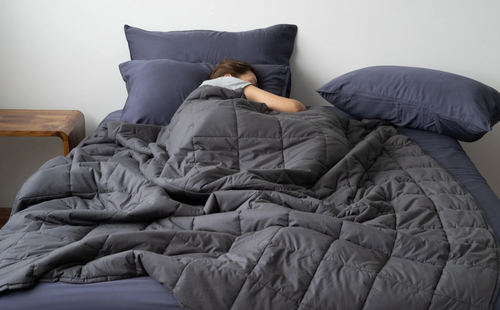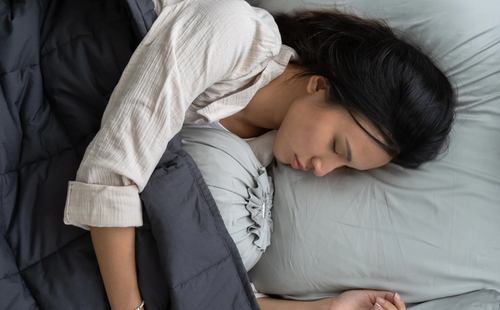At a Glance
Weighted blankets are popular for the deep touch pressure - props to the extra weight the filling gives. Let's get to know the different types to choose from.
Quick Tips
- If you are prone to allergies, choose hypoallergenic filling materials.
- Go for a machine-washable and dryer-friendly material.
- Consider your budget as well.

Featuring Weavve’s Weighted Blanket
Weighted blankets, or gravity blankets, have become increasingly popular due to their therapeutic benefits. They are said to mimic deep touch pressure stimulation, which relaxes the nervous system, produces a calming effect, and lowers the heart rate.
This simulation helps sleepers fall asleep faster and improve sleep quality. This is especially helpful for people with stress and anxiety, autism, and those dealing with chronic pain. Additionally, it eases the symptoms of anxiety disorder, Attention Deficit Hyperactivity Disorder (ADHD), and autism spectrum disorders.

Image by lea bonzer from Pexels
Because of the many weighted blanket benefits, more and more people are getting interested in trying them. If you are someone who wants to experience it for yourself, then one important thing you should know is that the pressure exerted depends largely on the filling materials stuffed inside the blankets.
Depending on the material you choose to use in your gravity blanket, the outcome of the pressure you feel will vary accordingly, so it is imperative that you find what is suitable for you personally.
What Are Weighted Blanket Filling Materials?

Featuring Weavve’s Weighted Blanket
Filling materials are stuffed inside weighed blankets. They are stitched inside square pockets and designed to conform to the curves of the body. Since they are heavy enough, they stimulate deep touch pressure that offers a sense of comfort and security.
8 Popular Filling Materials For Weighted Blankets

Image by Pixabay from Pexels
Knowing the different fillers is important for optimal comfort and safety. In addition, they will be in direct contact with the skin, so choosing safe, non-toxic materials is crucial.
To choose the right material, let’s take a closer look at the most common fillers, as well as the drawbacks and benefits of weighted blanket stuffing:
Plastic Poly Pellets

Image from plasticpellets.com
Poly pellets, also known as weighed stuffing beads, are one of the most commonly used fillers. They are usually made of polypropylene plastic, which is considered to be a safe level 5 plastic. This material is great because it easily follows the curve of the body once sewn into the fabric.
|
Pros |
Cons |
|
Cost-effective |
Not eco-friendly |
|
Non-toxic |
Can sometimes give off an initial odor |
|
Usually washable |
Can sometimes clump, causing uneven weight distribution |
|
Easily accessible |
Its uneven texture may feel abrasive for extremely sensory-sensitive individuals |
|
Long-lasting |
Micro Glass Beads

Image from hxglassbeads.com
Micro glass beads, considered the most luxurious filling material, are tiny glass fillers that look like white sand or salt crystals. They are cool to the touch, so they are usually used in cooling weighted blankets.
These make a great alternative to poly pellets because they are more eco-friendly. Micro glass beads also have a consistent shape and smooth edges. Because of this, they are ideal for those who tend to get bothered by the texture of poly pellets.
|
Pros |
Cons |
|
An environmentally friendly alternative to poly pellets |
More expensive than poly pellets |
|
Hypoallergenic |
Cheaper glass beads may contain lead |
|
Machine-washable |
Sometimes shift to the sides, causing uneven weight distribution |
|
Dry cleaner-safe |
More likely to leak through the stitches of the fabric |
|
Easily accessible |
|
|
Durable |
|
|
Odorless |
|
|
Less clumpy |
Nano-Ceramic Beads

Image from reade.com
Nano-ceramic beads are made using nano-particle technology, which involves mixing tiny ceramic particles within a solution and gel.
This material is excellent because it contains a high percentage of air, which means it’s lightweight. It is also durable, thanks to its outstanding strength and flexibility. Additionally, it blends better and creates a more balanced distribution than other materials.
|
Pros |
Cons |
|
Lightweight |
Not as readily available as other fillings |
|
Durable |
May be more expensive |
|
Extra small, which is perfect for those who are very sensitive to touch |
Steel Shot Beads

Image from tenroadsglass.com
This material promotes calm and comfort since it has a completely smooth, round surface. However, the beads are heavy, so they may be too noisy when moved.
|
Pros |
Cons |
|
Cost-effective |
Can be noisier than glass beads and plastic pellets |
|
Washing machine-safe |
Can feel lumpy on the body |
|
Extremely durable |
|
|
Doesn’t leak through the stitches of the fabric easily |
Crystals

Image by Dids from Pexels
Crystals are believed to hold vibrational frequencies that promote natural healing. When combined with deep touch pressure, they potentially offer a more restorative sleep. For this reason, some are drawn to using them as fillers for their homemade weighed blankets.
|
Pros |
Cons |
|
Ideal for people who believe in holistic healing |
Expensive |
|
Not as easy to wash as other stuffing |
|
|
May feel lumpy, depending on the cut and finish of the crystals |
Sand

Image by Aleksandar Pasaric from Pexels
Sand is a common filler that is cheap and easy to buy. Unfortunately, washing and drying a fabric stuffed with this material is challenging.
Since it is extremely fine, this material can clump and cause the outer fabric to lose its shape after the first wash. Items filled with sand must also be air-dried, so drying takes longer.
|
Pros |
Cons |
|
Inexpensive |
Tends to clump |
|
Easily accessible |
Washing and drying are difficult |
|
Likely to leak through the stitching |
Dried Foods

Image by Mike from Pexels
Dried foods, such as beans, rice, barley, or corn, are sometimes turned into filling materials. They are not common in commercially available bedding, but they are often used by those who prefer homemade ones.
This material may be cheap, but it isn’t an ideal filler. Food eventually disintegrates and rots, so using it might eventually mean having smelly and infested bed linen.
Additionally, cleaning a blanket filled with food can be a nightmare. Since food is porous, it will retain water without completely drying out. As a result, it becomes moldy after the first wash.
|
Pros |
Cons |
|
Inexpensive |
Food might break down over time |
|
Easily accessible |
Not durable |
|
Can grow mold and fungus |
|
|
May give off an odor |
|
|
May attract insects |
Rocks

Image by Scott Webb from Pexels
Riverstones, pebbles, and gravel are commonly used as homemade weighted fillers. These are small, light, and similar in size to ensure even weight distribution.
Before sewing them into the lining, these rocks are completely dried out to avoid mold growth. Padding is also added for comfort.
|
Pros |
Cons |
|
Cost-effective |
May cut through the fabric due to sharp edges |
|
Easily accessible |
Tend to feel lumpy on the body |
|
May feel too warm for hot sleepers |
|
|
May feel uncomfortable for individuals with sensory sensitivities |
How To Choose The Best Filling For Weighted Blankets

Image by Kristin Vogt from Pexels
Besides knowing its advantages and disadvantages, here are other factors to consider when choosing a weighted blanket filling material:
Sensitivities
Some fillers, like steel beads and rocks, may rustle when moved. This noise can be bothersome for people with auditory irritations. Those dealing with sensory sensitivities may also get irritated by uneven weight distribution. That said, consider your sensitivities and steer clear of filling materials that tend to cause discomfort.
Allergies
Some fillers are made of plastic or organic materials. If you have sensitive skin or allergies to artificial or organic ingredients, don’t buy weighted blankets filled with poly pellets, dry foods, and sand.

Image by Ivan Oboleninov from Pexels
Budget
Filling materials can be cheaper or more expensive, depending on their manufacturing process. Consider your budget and check options that offer the best quality for the price to get the most out of your blanket.
Convenience
Clean bed linen makes for an ideal sleep environment. This is why choosing a machine-washable and dryer-friendly material is essential.
If you tend to sweat at night, go for beaded fillers since they’re easier to wash. Also, don’t wash blankets filled with porous materials, like sand, beans, and grains, to avoid having bed linen with decomposing fillers.
Preferences
Ultimately, the best filler depends on your sleeping needs and preferences. Do you prefer eco-friendly materials? Or would you prioritize comfort and texture? Remember that this can be your ultimate cuddle buddy so choose carefully.
Discover Weavve's Collection
Weighted Blanket

Our queen weighted blanket consists of 100% polyester & lead-free glass bead filling. It is designed with smaller compartments for even weight distribution, helping you relax by simulating the feeling of being held or hugged.
Additionally, it is hypoallergenic and non-toxic with a breathable fabric that is machine and dryer safe, so you can be sure to get restful sleep every night.
Shop Weighted Blankets Singapore
TENCEL™ Lyocell Duvet

The first in Singapore featuring 100% pure TENCEL™ Lyocell fibers inside and out, this duvet provides excellent thermal regulation properties. You can rely on getting maximum comfort and rest all night, any season.




































